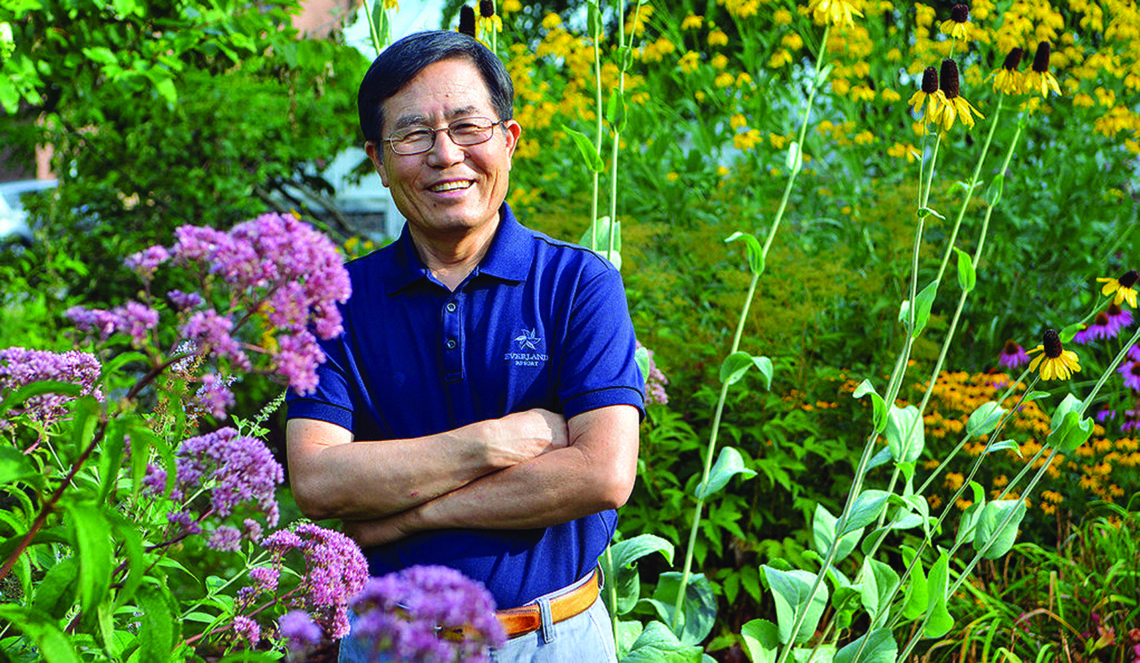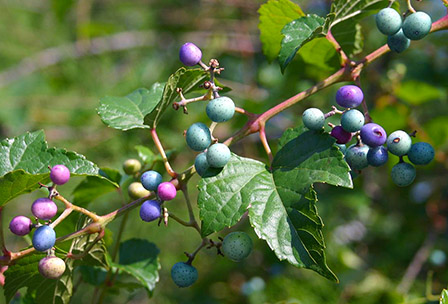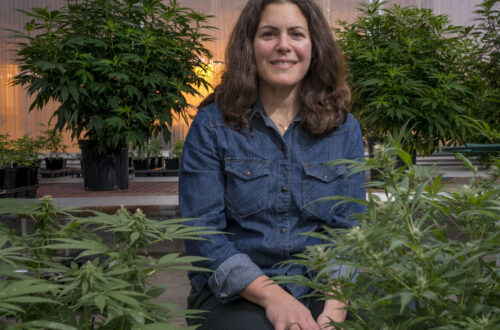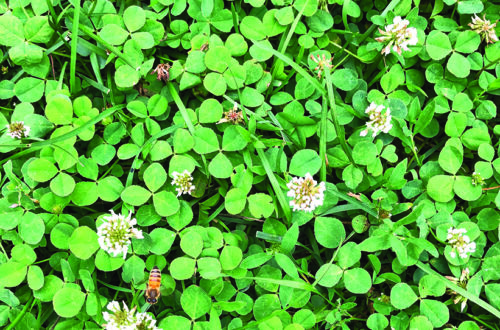By Susan Gonzalez
While leading a group of Girl Scouts on a tour of Yale’s Marsh Botanical Garden not so long ago, curator Kunso Kim spoke about flowers’ dependence upon bees, butterflies, and birds for pollination, and what the plants provide their pollinators in return – the nectar that is their food.
This story first appeared in YaleNews on Dec. 2, 2019
Kim, who became associate director of the botanical garden late last year, also emphasized for the children the symbiotic relationship between plants and humans. “We cannot exist on earth without plants,” he said. “I touch upon aspects of conservation with them at a level that is easy for them to undestand. We’ve got to help protect plants in a world where they are rapidly disappearing. This is the bottom line.”
The nearly eight-acre Marsh Botanical Garden, nestled north of campus on a hillside between Prospect and Mansfield Streets, is home to over 1,200 species of plants, including a variety of trees, shrubs, and grasses. Among them is a giant white oak that is the oldest tree on campus (Kim calls it “a witness to Yale”) and a dawn redwood, a species that was believed extinct until one was discovered 75 years ago in a remote part of China. Though its seeds were distributed to botanical gardens around the world, the redwood – still endangered – is known as a “living fossil.”
Since his arrival on campus last December, Kim has been working with the Marsh Botanical Garden’s director, Erika Edwards, a professor of ecology and evolutionary biology who is also curator of botany at the Peabody Museum of Natural History, on developing plans to restore the garden – often called a “hidden gem” by its visitors – to make it the showplace it once was in the 1930s and 1940s. In its heyday, the Yale garden attracted some 10,000 visitors a year.
Kim manages the garden’s daily operations and maintenance, and has been sharing its botanical treasures, common and rare, during tours, in conversations, and via social media. He posts Facebook pictures of flowers and trees during their blooming or fruit-bearing seasons, hoping to spread word of all the garden has to offer and to entice community members to visit. Last June, for example, he posted about the progress of a corpse flower (Amorphophallus titanum), an infrequent bloomer that emits a putrid odor like rotten meat or a decaying body. It’s the type of plant, Kim notes, that attracts the attention of both plant lovers and the simply curious.
“The Marsh Botanical Garden is a ‘living museum,’ as valuable as the Yale University Art Gallery, the Yale Center for British Art, or the Peabody Museum of Natural History,” said Kim. “I’d like to bring back the legacy of the garden, making improvements that will help to make it the best university and community resource it can be.”
Yale acquired the garden’s site in 1899, when paleontologist Othniel C. Marsh – the famed dinosaur fossil excavator and Yale professor – bequeathed his four-story home, grounds, greenhouses, and plant collections to the university. He stipulated that the property be used only as a botanical garden. The home, now called Marsh Hall, today is part of the School of Forestry & Environmental Studies. The plants in the garden’s six greenhouses, which include special collections of desert plants, tropical plants, and carnivorous plants, are used for faculty and student research and for teaching in courses ranging from plant diversity and evolution to genetics to sculpture. Several of the greenhouses are also open to the public, as is the land and its gardens.
The renowned landscape architect Beatrix Farrand originally designed and planted the gardens between 1924 and 1939. Her design featured a systematic garden, which provided guests with a real-life illustration of the evolution of plants, as well as a rock garden and a formal garden modeled after the world’s oldest existing formal garden, in Padua, Italy.
The garden fell into neglect around World War II, and some of its trees were destroyed by disease and storms. While there have been efforts in recent years to restore the garden, Edwards and Kim say they are committed to elevating the garden from its status as a “hidden gem” to a campus attraction.
“Whether we attempt to replicate Farrand’s designs fully or partially, or do something different to illustrate how science has changed since then, our goal is to help people connect with nature and environmental issues, and to help them be fascinated and inspired by the botanic garden,” Kim says.
Edwards, who joined the Yale faculty in 2017 and assumed leadership of the garden in 2018, says she feels “the stars may finally be aligning” to advance that mission.
“There is nothing more magical than a well-cared-for botanical garden,” she says. “Recruiting Kunso to join us, with his years of experience in collections curation and horticulture, provided just the right balance of expertise to our long-time staff, who are so exceptional at supporting our research programs. Now we might finally have the right combination to get something going outside again – to get back to our roots.”
Other garden staff include longtime horticulturist David Garinger, who tends to the greenhouse teaching collections; Christopher Bolick, who manages the plant research operations, including the state-of-the-art indoor plant growth facilities in the new Yale Science Building; and research aides Robert Rak and Eileen Williams. Routine maintenance is handled by the University’s Grounds Maintenance department.
Kim is also assessing the greenhouse collections with the dual goals of making them as useful as possible to students and faculty whose work and study revolves around them.
“Our top priority for the botanical garden is first to support Yale’s teaching and research missions,” he said, noting that the plant collections are studied by students in schools as varied as Architecture and Forestry & Environmental Studies, and in departments ranging from Geology and Geophysics to Ecology and Evolutionary Biology to Molecular, Cellular, and Developmental Biology.
Working at an arboretum in his seaside hometown of Chollipo, South Korea, piqued Kim’s own interest in plants when he was a teenager.
“I helped unwrap all the packages of plants the arboretum acquired,” he said. “Some of them were unique and exotic plants, and I thought, ‘Wow, this is kind of cool!’ ”
Kim’s enthusiasm led him to apply to international horticultural internship programs, including one at the Savill Garden in the Crown Estate, England. On full scholarship, he later studied in the Longwood Graduate Program at the University of Delaware.
Since then, he has worked at the Norfolk Botanical Garden in Norfolk, Va., the Morton Arboretum in Lisle, Ill., and Powell Gardens in Kansas City, and he led the implementation of a horticultural master plan for a theme park at Samsung C&T Corporation in South Korea. His work gave him the opportunity to travel the world to collect seeds of rare and endangered plants growing in the wild, including to remote jungles in China.
Everywhere he has traveled, he says, he has witnessed the effects of development and urbanization on the natural landscape.
“There is not much of our natural environment left,” he says.
It’s one of Kim’s top goals to welcome young people to the Marsh Botanical Garden, both as a place of learning and as a “sanctuary, where they could come to explore or simply to meditate,” he said.
“Being here, where they can be in a natural setting and see plants, helps them understand the importance of biodiversity,” he said. “Also, it is wonderful when students come and get their hands dirty, touching the soil and plants and learning how to distinguish the good guys from the bad guys!”
Realizing the garden’s full potential, Kim says, will further help to ensure its “resilient and sustainable” future.
“When people appreciate the garden, we are building advocates for environmental conservation, which means that this garden – and other natural landscapes – can be enjoyed by many future generations.”
The Marsh Botanical Garden is open to the public Monday to Friday, 9 am to 4 pm. It’s located at 265 Mansfield St. in New Haven. Admission is free. marshbotanicalgarden.yale.edu






